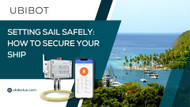Setting Sail Safely: How to Secure Your Ship
Posted by UBiBot USA on May 6th 2024
Embarking on a maritime adventure can be thrilling, but ensuring the safety of everyone aboard should always be the top priority. From enjoying the waves of treacherous waters to solving sudden emergencies, a ship should be equipped to deal with anything that the sea throws at it.
But which safety features should a ship have? Let's take a look.
7 Safety Features a Ship MUST Have
Fire Alarms and Suppression Systems:
Fire is one of the most feared hazards at sea, capable of spreading rapidly and engulfing a ship in flames. It is ironic that the one thing fire is afraid of can't do anything when there is fire on a ship –as the sip burns, water just watches. This is why there should be a foolproof fire alarm and suppression system so that as soon as even a little smoke rises, the alarms sound, and everyone is alert.
Marine Radios:
It is important to always be in contact with the shore or other ships when you are in the middle of the sea. This way, you can communicate and tell others if there is any issue. Shore stations, maritime authorities and other responsible people are able to provide a quick response and send rescue operation teams.
Flood Leak Detectors:
Remoteflood leak detector is usually used in the bottom most part of the ship –the bilge. So that as soon as there is even a slight water leakage, the detector detects it in real-time. You can get early warnings of damage –allowing the crew to take quick action.
Flares and Distress Signals:
In case of an emergency, distress signals like flares are crucial for attracting attention and signaling for help. Ships must have a variety of distress signals like parachute flares, hand flares, smoke signals, SOS signals, etc. This can help ship to become visible to far areas and vessels even in low visibility conditions.
Bilge Pumps:
Bilge pumps play an important role in keeping ships afloat by removing excess water from the bilge, the lowest compartment of the vessel. In the event of flooding or water ingress, bilge pumps help prevent water from accumulating and causing the ship to become unstable or sink. This pump should be regularly checked to ensure it works fine.
Lifeboats:
Lifeboats and life rafts are essential for evacuating passengers and crew in a maritime emergency, such as fire, flooding, or sinking. These survival craft provide a means of escape from the ship and offer shelter and protection until rescue arrives. Ships must have an adequate number of lifeboats and life rafts to accommodate all the crew and travelers.
Emergency Lighting and Escape Routes:
In emergencies such as power outages or fire, visibility can be severely compromised, making it challenging to navigate the ship and evacuate safely. Emergency lighting illuminates in such cases, showing a path to the nearest exit like an escape route or stairwell. With emergency lighting, people can reach the deck safely and quickly.
Conclusion:
Being in the middle of the sea is adventurous but also dangerous. If you own a ship or are an adventurer on a ship, you should check that the ship has all the safety features on it. Prioritizing your and others' safety is important, especially on a ship.

